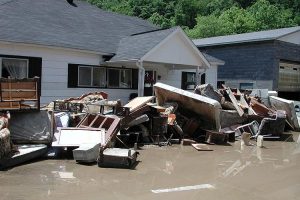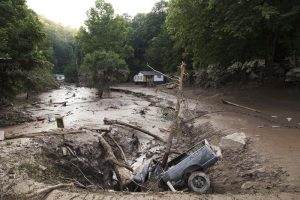What are the Effects of Mountaintop Removal on Families and Communities?
Coal companies are allowed to mine up to 300 feet from homes. This is dangerous for families and damaging to homes and property values.
Property values plummet from communities near mining sites leaving life long residents no option but to sell to the coal companies or live with the continual blasting from 24 hour-a-day mining operations. In the town of Blair, West Virginia, the coal company purchased property for a pittance from homeowners then forced sellers to sign a contract stating they would never move back to the area or publicly denounce the company.

Toxins from coal impoundments leech into the soil and groundwater in coalfield communities. These toxins are not removable once they enter the soil and water. They are known to bioaccumulate in the food chain, so the long-term effects are yet to be fully evaluated.
Mountaintop removal strip mines regularly set off blasts with 10 to 100 times the force of the Oklahoma City bombing. These blasts shake and crack homes, destroy wells and roll huge rocks into peoples’ yards and public roads. Mines have blasted rocks and debris into homes and cars, making it dangerous in some areas for people to work in their yards or allow children to wait outside for the school bus.
As a result of the nation’s demand for cheap, low-sulfur coal – the kind found in Appalachia – residents in the small mountain communities are losing their way of life. Many small towns are losing their populations and economies because of the negative effects that mountaintop removal mining has on jobs and the environment. In many instances, citizens are being forced to abandon their family lands due to the intense water pollution and the danger of living in the vicinity of the blasting.
In addition, the unique way of life found in these small communities is threatened because the survival of the culture is dependent on the survival of the mountain ecology. As coal companies chew up ever-expanding tracts of land, community residents lose access to the forests where they traditionally hunt and gather plants such as ginseng, mushrooms, and ramps. And the destruction of the mountains themselves, objects of great reverence and the spiritual attachment for people in West Virginia, is an indescribable blow to the hearts of folks who have spent their entire lives nestles in these protecting hills. Source: Jessica Azulay: “West Virginia, National Sacrifice Area”: Znet Sustainer Program: December 6, 2002: available: http://www.zmag.org/content/showarticle.cfm?SectionID=1&ItemID=2713
Even government agencies that regulate mountaintop removal agree that the effects on nearby homes and communities can be devastating. In their Mid-Atlantic Regional Assessment, the Environmental Protection Agency states:
“The impact of mountaintop removal on nearby communities is devastating. Dynamite blasts needed to splinter rock strata are so strong they crack the foundations and walls of houses. Mining dries up an average of 100 wells a year and contaminates water in others. In many coalfield communities, the purity and availability of drinking water are keen concerns.”

In addition to the frequent loss or pollution of drinking water, families living near mountaintop removal sites contend with:
FLOODING — Coalfield residents have long complained about drastic increases in flooding following mountaintop removal operations,. The coal industry maintains such floods are “Acts of God.” Researchers at the University of Kentucky recently concluded: “there is a clear risk of increased flooding (greater runoff production and less surface flow detention) following [mountaintop removal and valley fill] operations.”
BLASTING — Families and communities near mountaintop removal sites are forced to contend with continual blasting from mining operations that can take place up to 300 feet from their homes and operate 24 hours a day. The impact of blasting not only makes life all but unlivable in nearby homes it also frequently cracks wells and foundations. Blasting can also send boulders flying hundreds of yards into roads and homes.
SLUDGE DAMS — Sludge dams represent the greatest threat to nearby communities of any of the impacts of coal mining. Impoundments are notoriously leaky, contaminating drinking water supplies in many communities, and are also known to fail completely. A sludge dam breach in Martin County, KY, in 2000, sent more than 300 million gallons of toxic coal sludge into tributaries of the Big Sandy, causing what the EPA called, “The biggest environmental disaster ever east of the Mississippi.”

